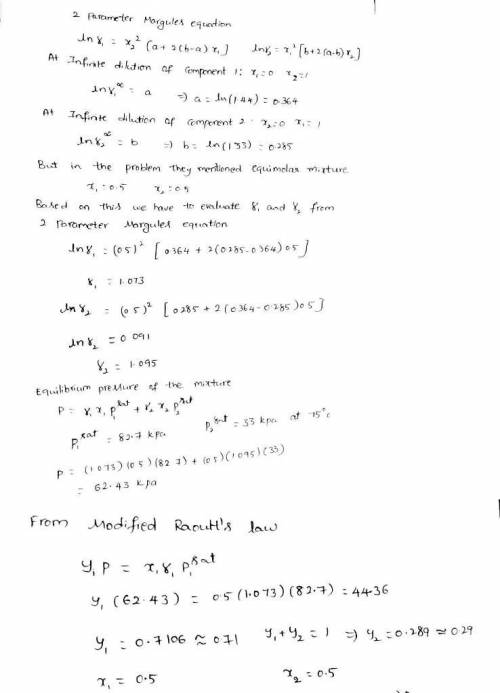
100 moles per minute of an equimolar mixture of methyl ethyl ketone (1) and toluene (2) are flashed from 760 mm Hg to 460 mm Hg at 75 C. You know, experimentally that the infinite dilution activity coefficient of methyl ethyl ketone in toluene is 1.44 at this temperature. Likewise, you know that the experimental value for infinite dilution activity coefficient of toluene in methyl ethyl ketone is 1.33 at this temperature. Solve for the composition and amount of each equilibrium phase if the liquid is treated as modeled by the 2-parameter Margules equation.

Answers: 2
Another question on Chemistry

Chemistry, 22.06.2019 01:00
Which of the following is always a reactant in a combustion reaction? oxygen nitrogen hydrogen carbon
Answers: 1

Chemistry, 22.06.2019 01:50
Ase your answer to this question on the information below.hydrocarbons and fissionable nuclei are among the sources used for the production of energy in the united states. a chemical reaction produces much less energy than a nuclear reaction per mole of reactant.the balanced chemical equation below represents the reaction of one molecule of a hydrocarbon with two molecules of oxygen.chemical equation: ch4 + 2o2 → co2 + 2h2o + 1.48 × 10−18 jthe nuclear equation below represents one of the many possible reactions for one fissionable nucleus. in this equation, x represents a missing product.nuclear equation: write an isotopic notation for the missing product represented by x in the nuclear equation.
Answers: 1

Chemistry, 22.06.2019 02:10
When 225mg of anthracene, c14h10(s), was burned in a bomb calorimeter the temperature rose by 1.75k. calculate the calorimeter constant. by how much will the temperature rise when 125mg of phenol, c6h5oh(s), is burned in the calorimeter under the same conditions? (δch< (c14h10,s)=–7061 kj mol−1.)
Answers: 3

Chemistry, 22.06.2019 15:00
Which theory was contradicted by experiments with the photoelectric effect? light spreads out after it passes through a small opening. as soon as light strikes metal, electrons will be ejected. visible light, regardless of color, will cause the ejection of electrons when striking metal. the kinetic energy of ejected electrons depends on the frequency of light that strikes the metal.
Answers: 2
You know the right answer?
100 moles per minute of an equimolar mixture of methyl ethyl ketone (1) and toluene (2) are flashed...
Questions

Mathematics, 02.09.2021 03:00

Mathematics, 02.09.2021 03:00


Mathematics, 02.09.2021 03:00



Computers and Technology, 02.09.2021 03:00




Mathematics, 02.09.2021 03:00

History, 02.09.2021 03:00




Mathematics, 02.09.2021 03:00

Mathematics, 02.09.2021 03:00


Mathematics, 02.09.2021 03:00




